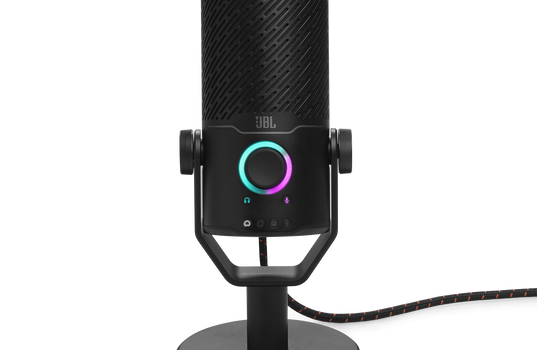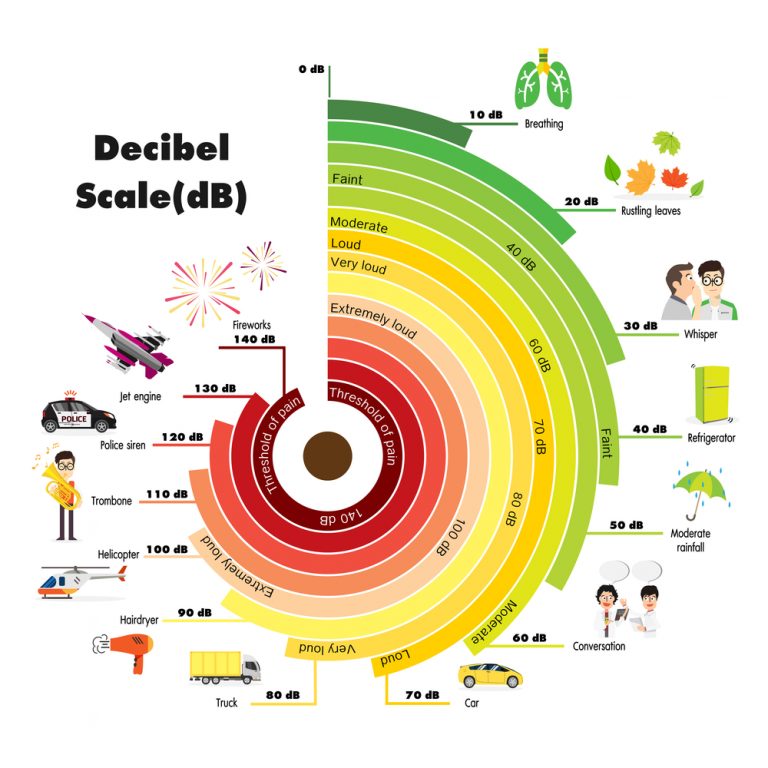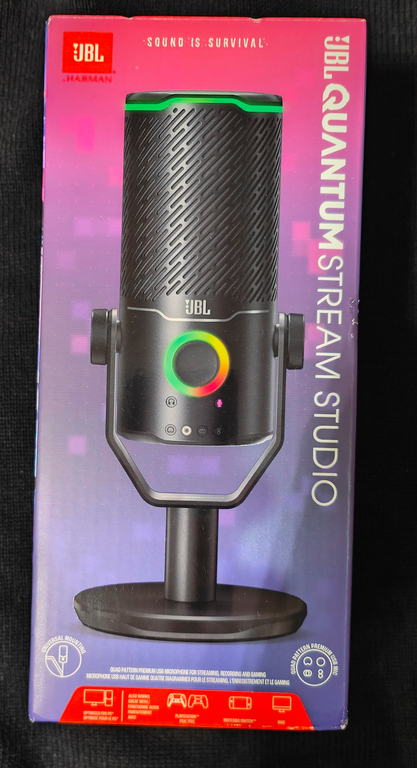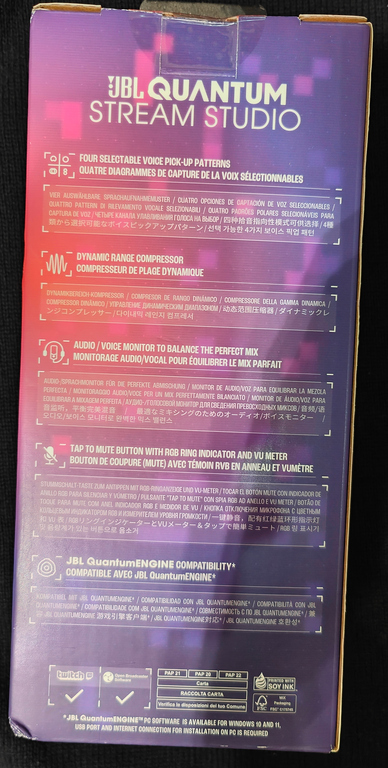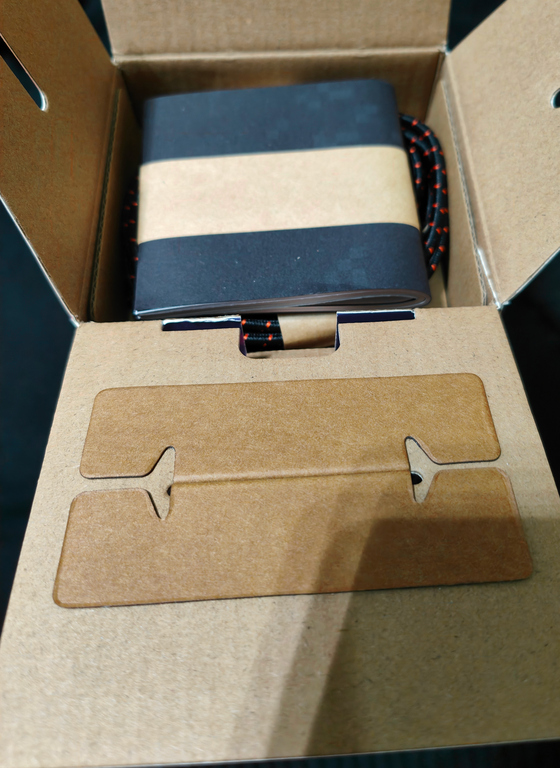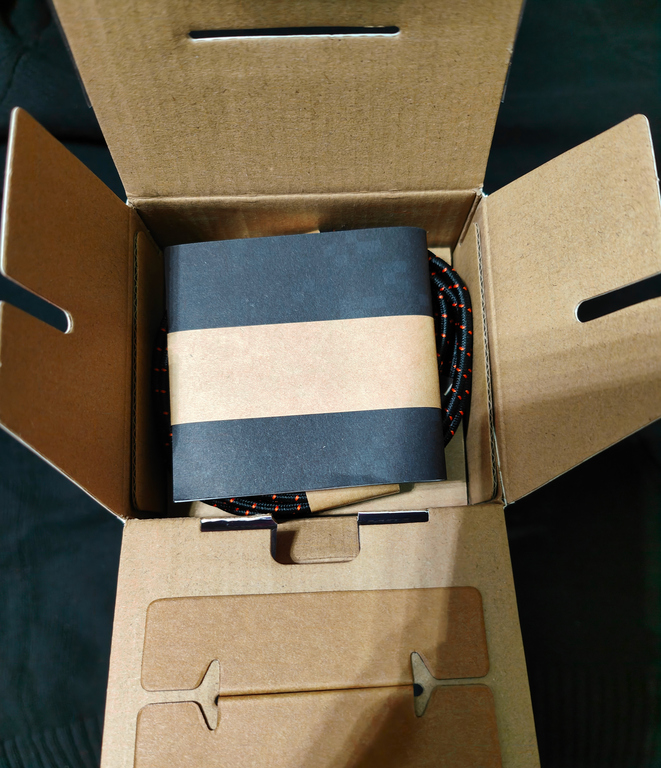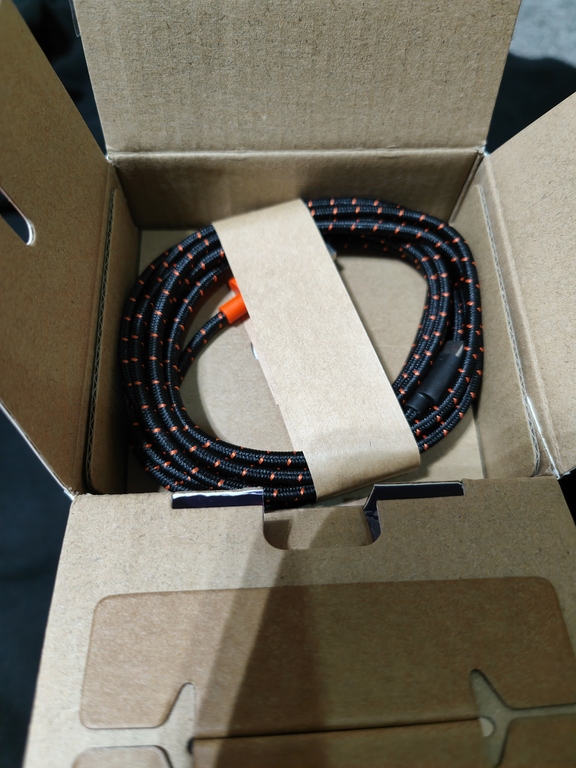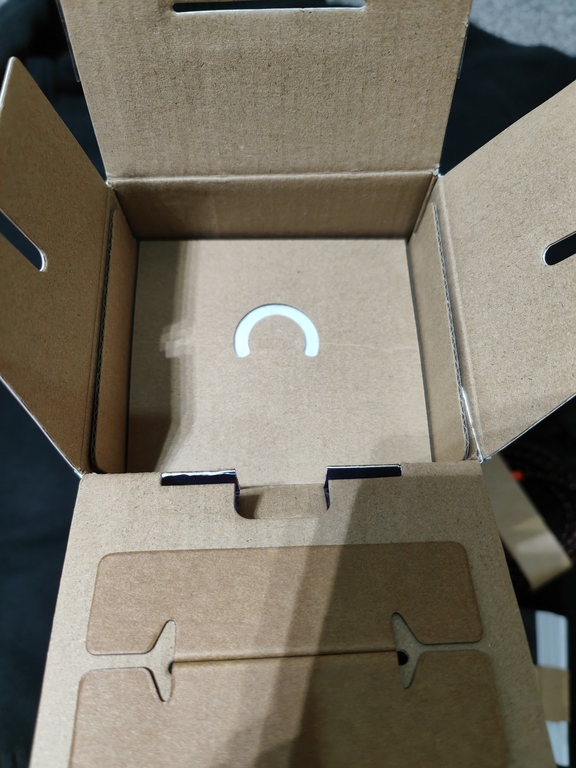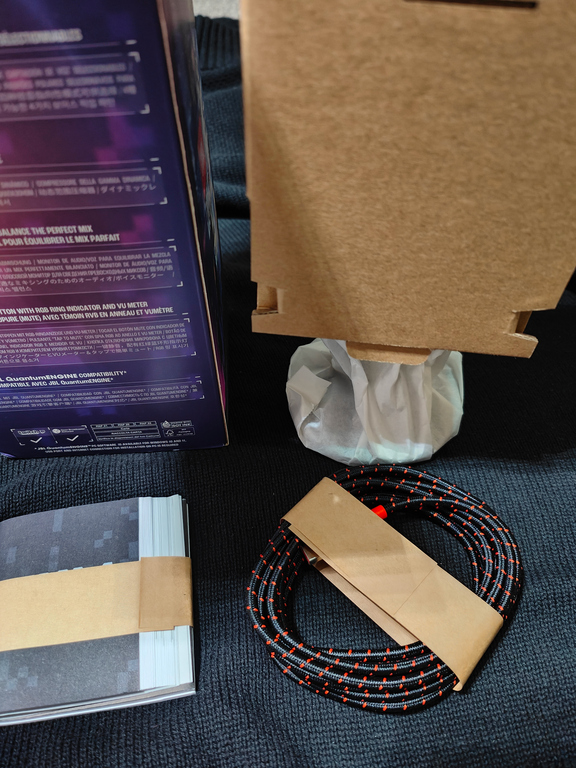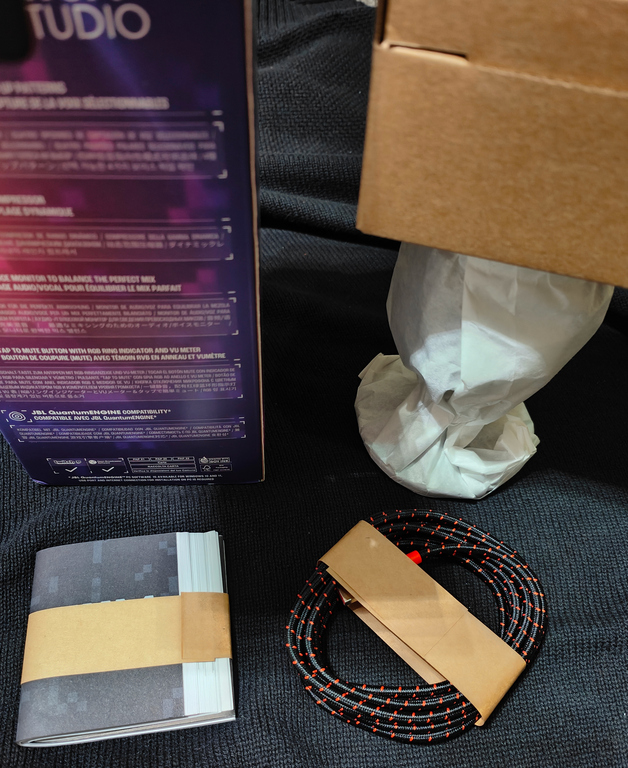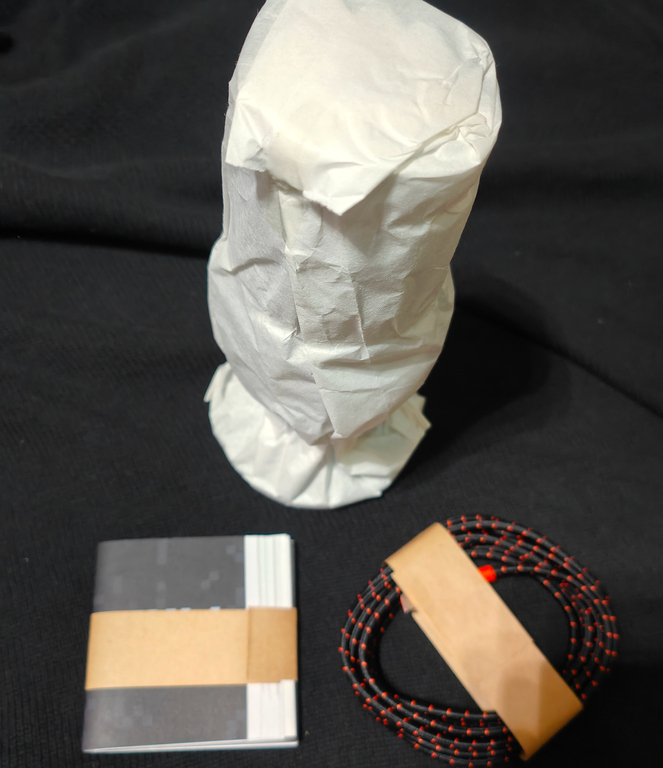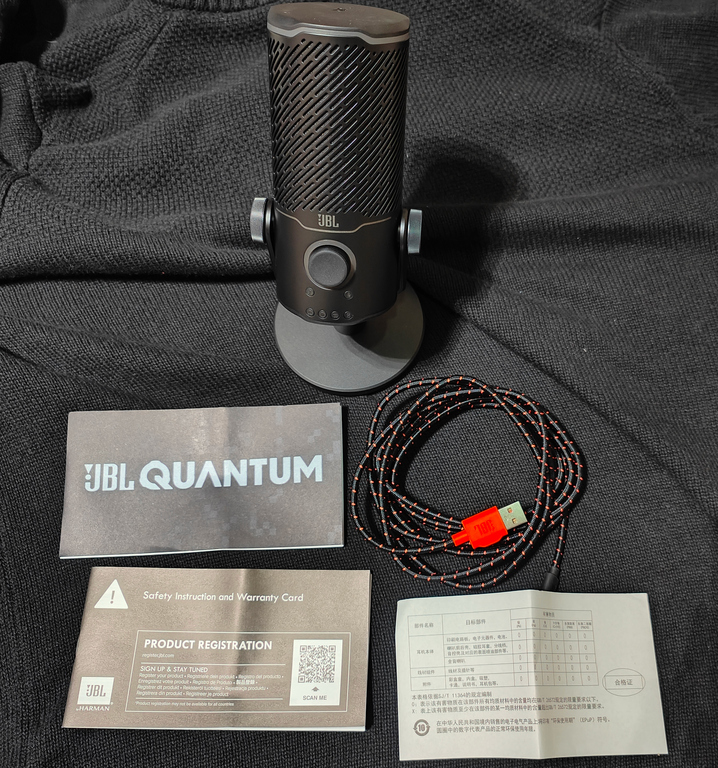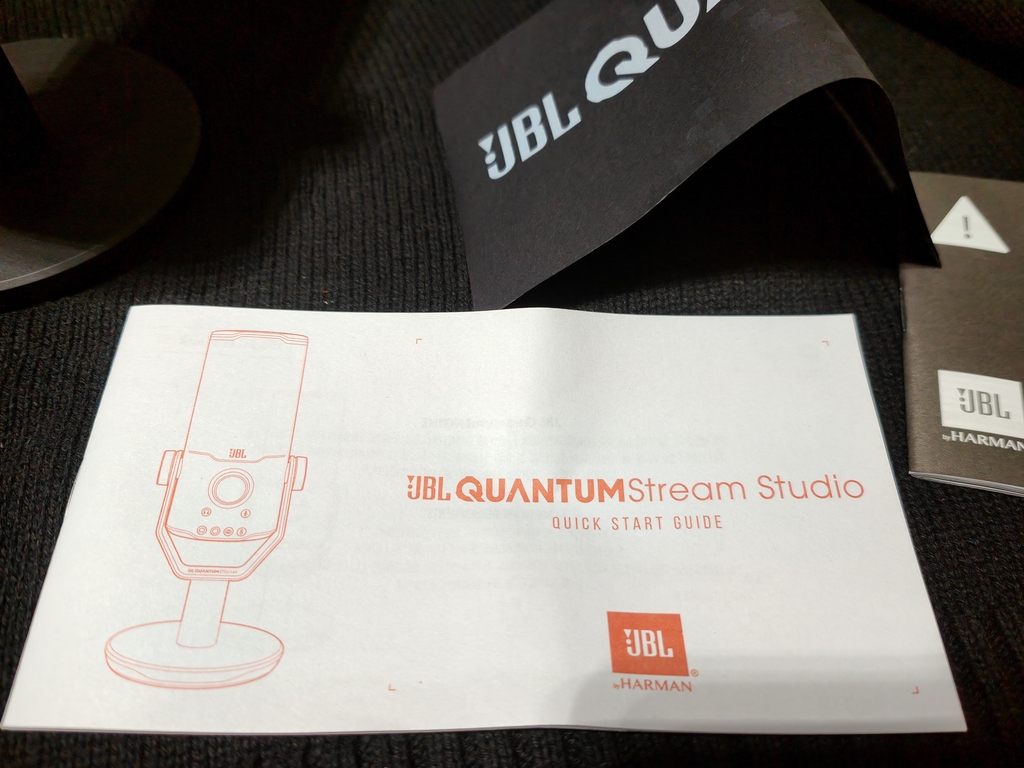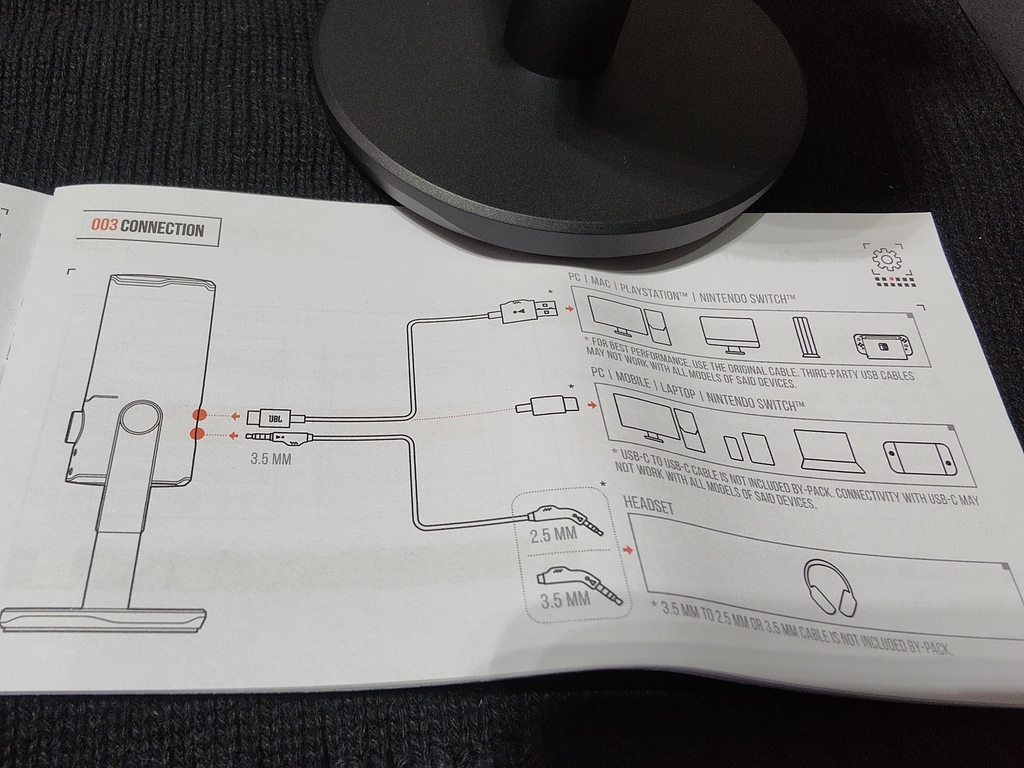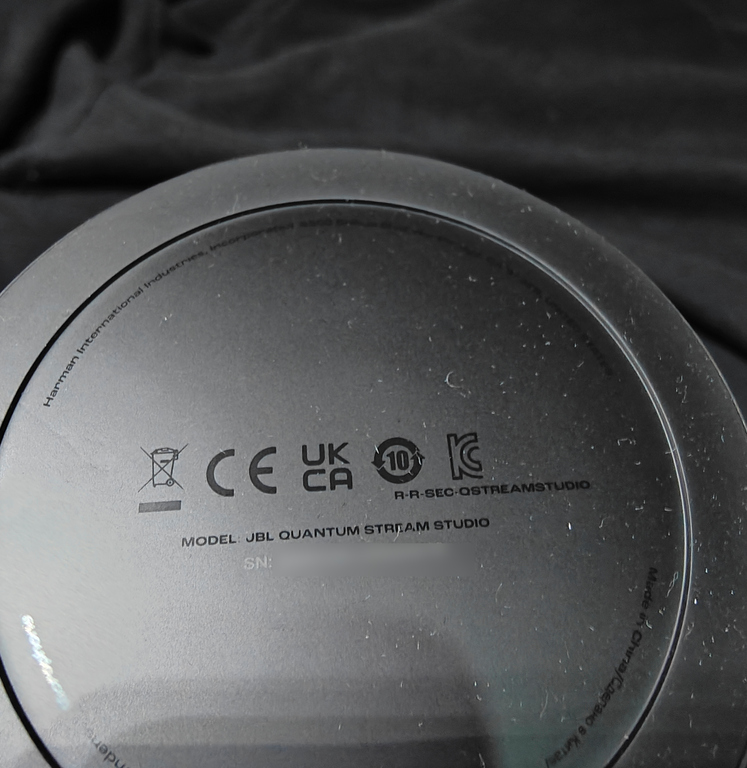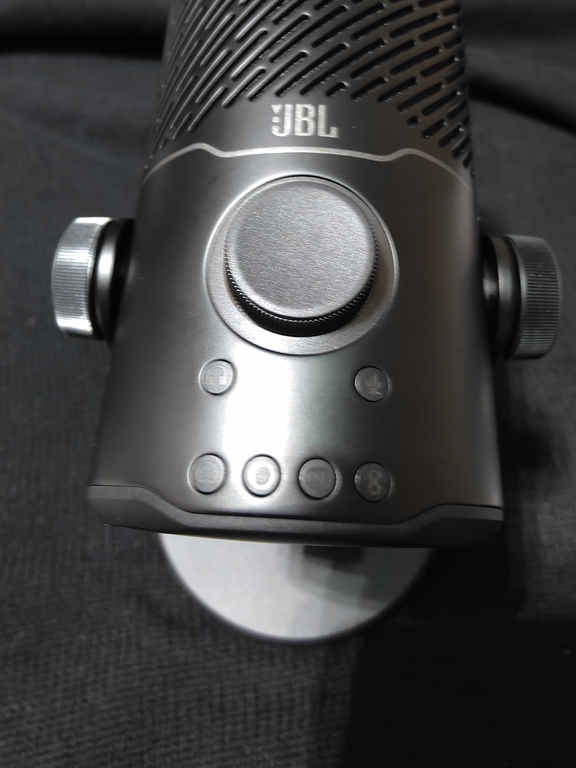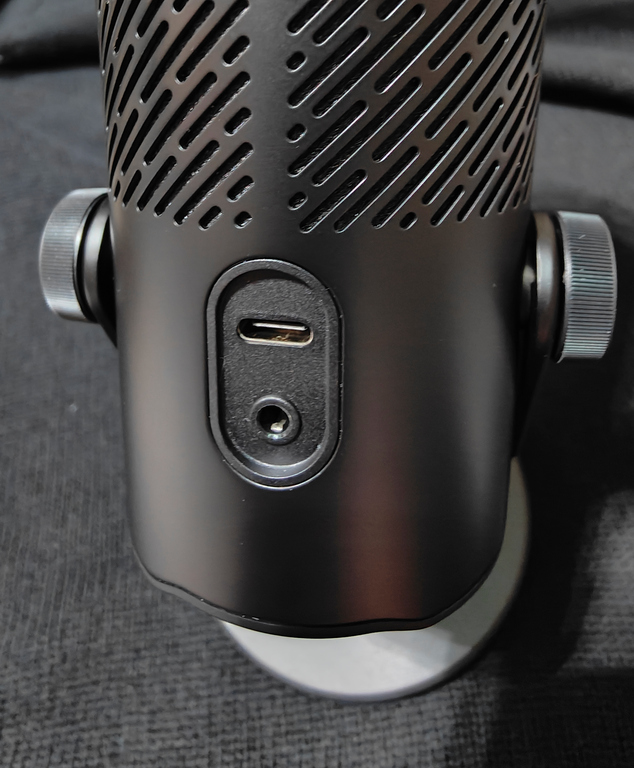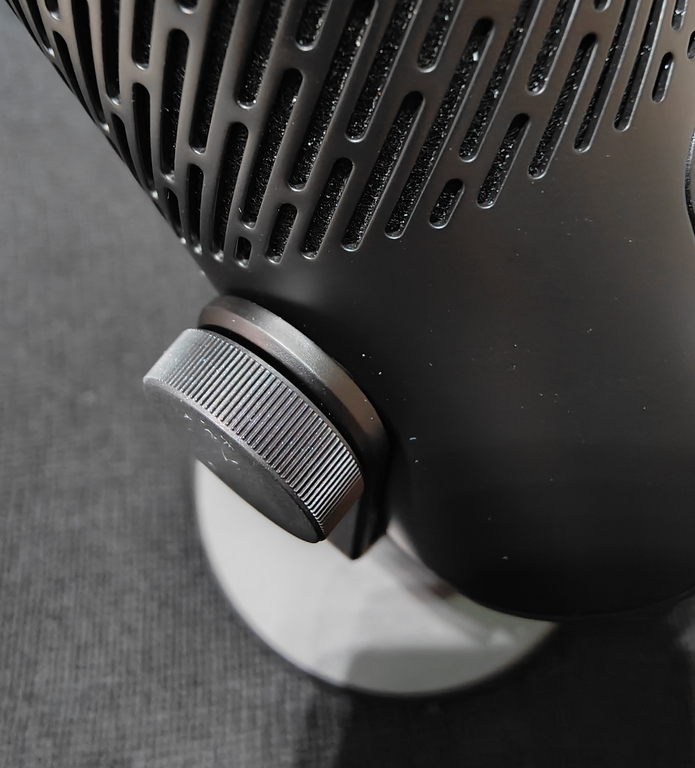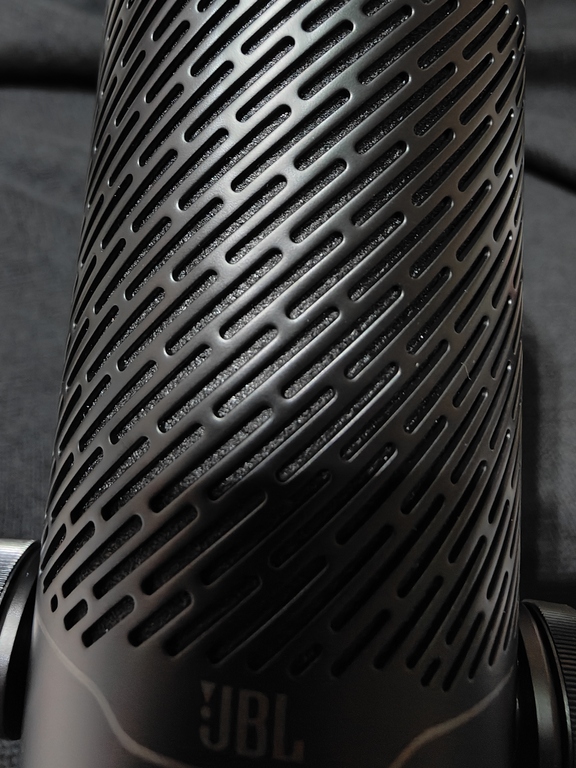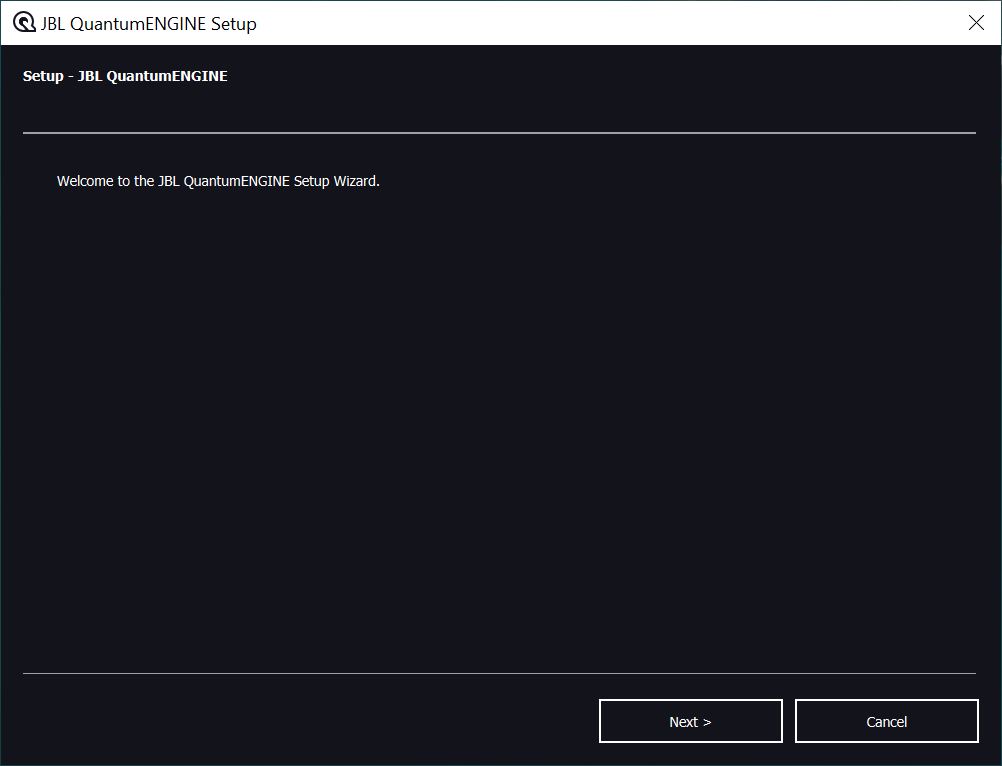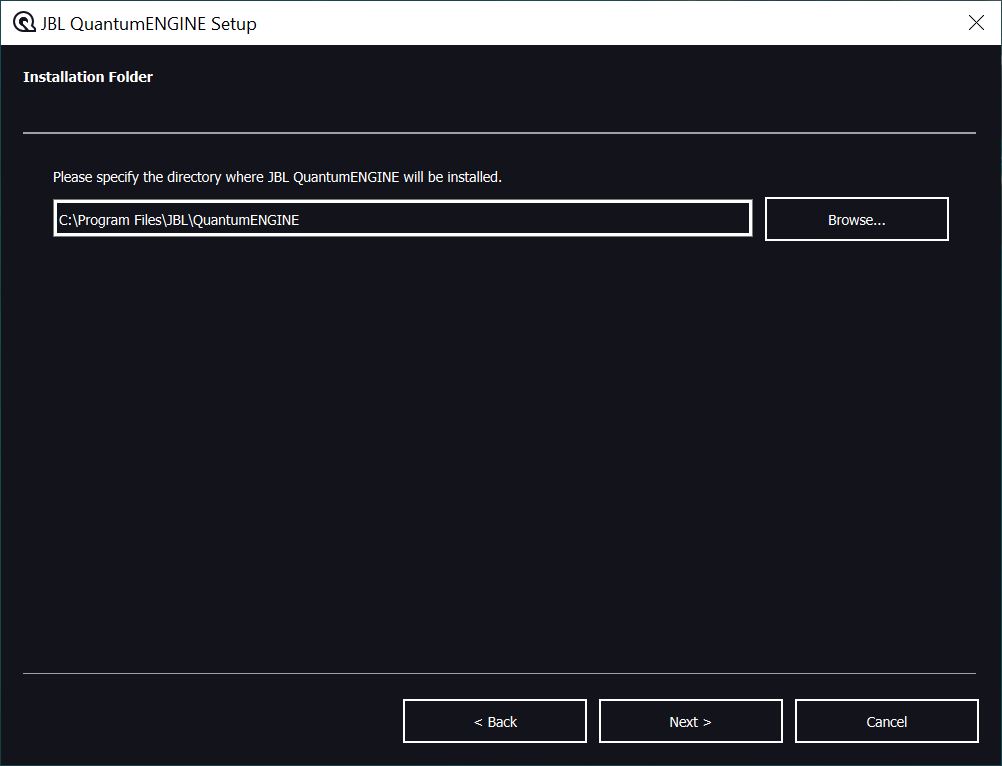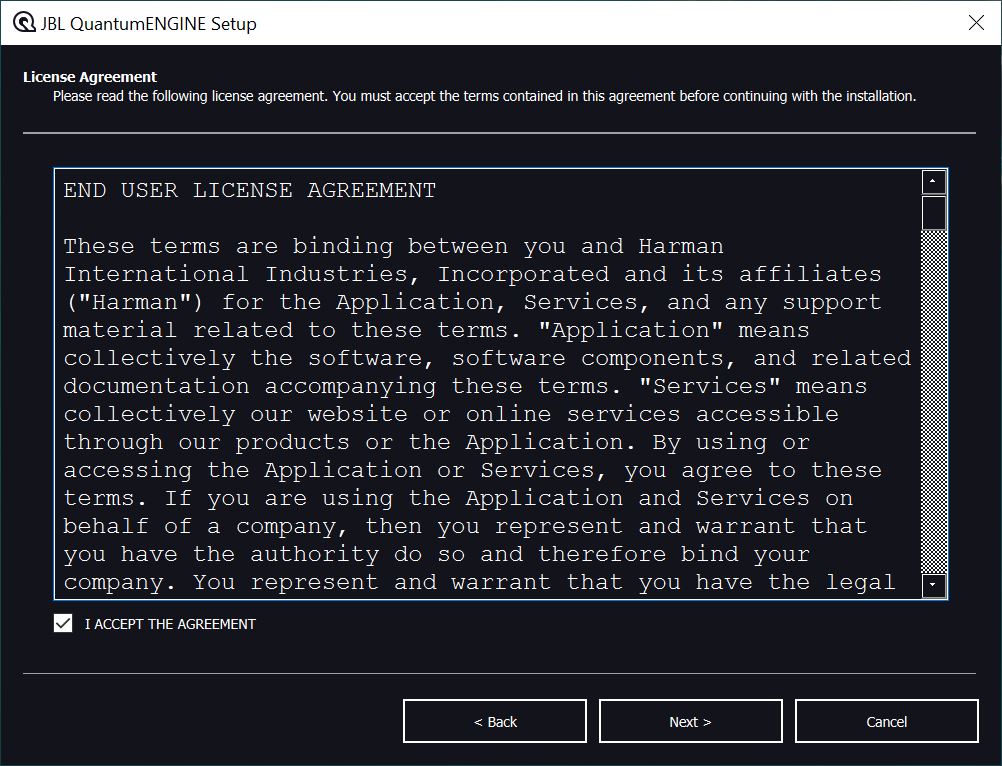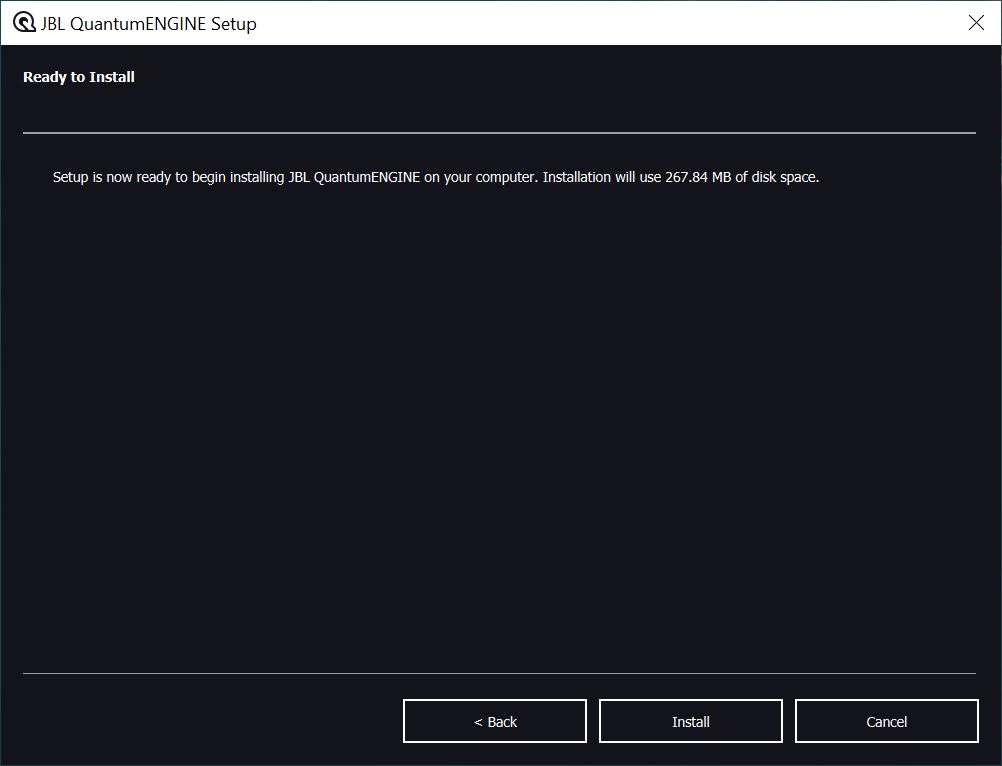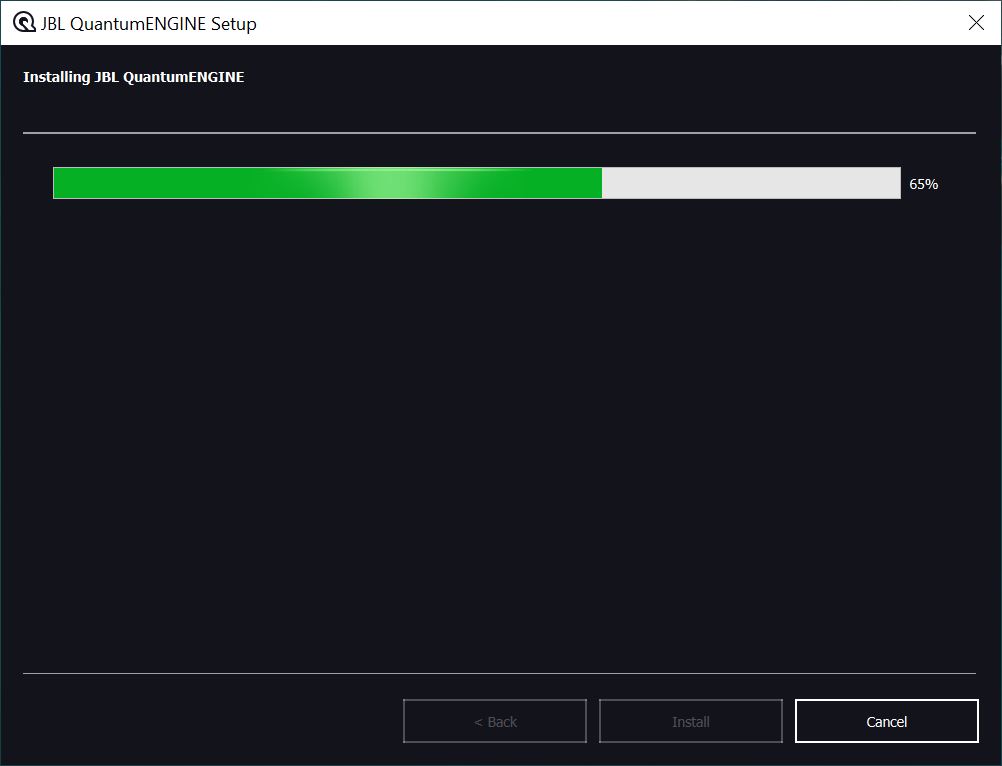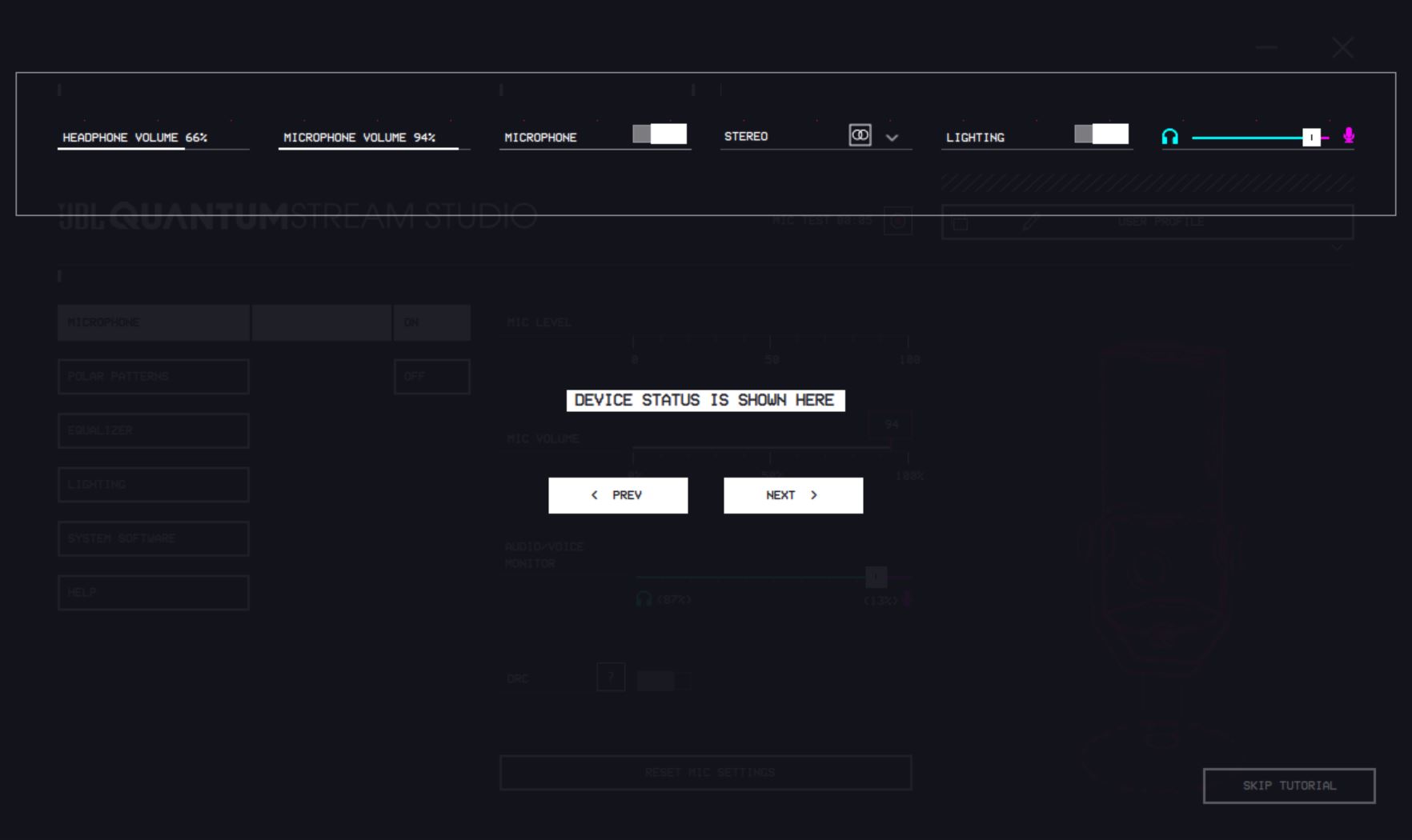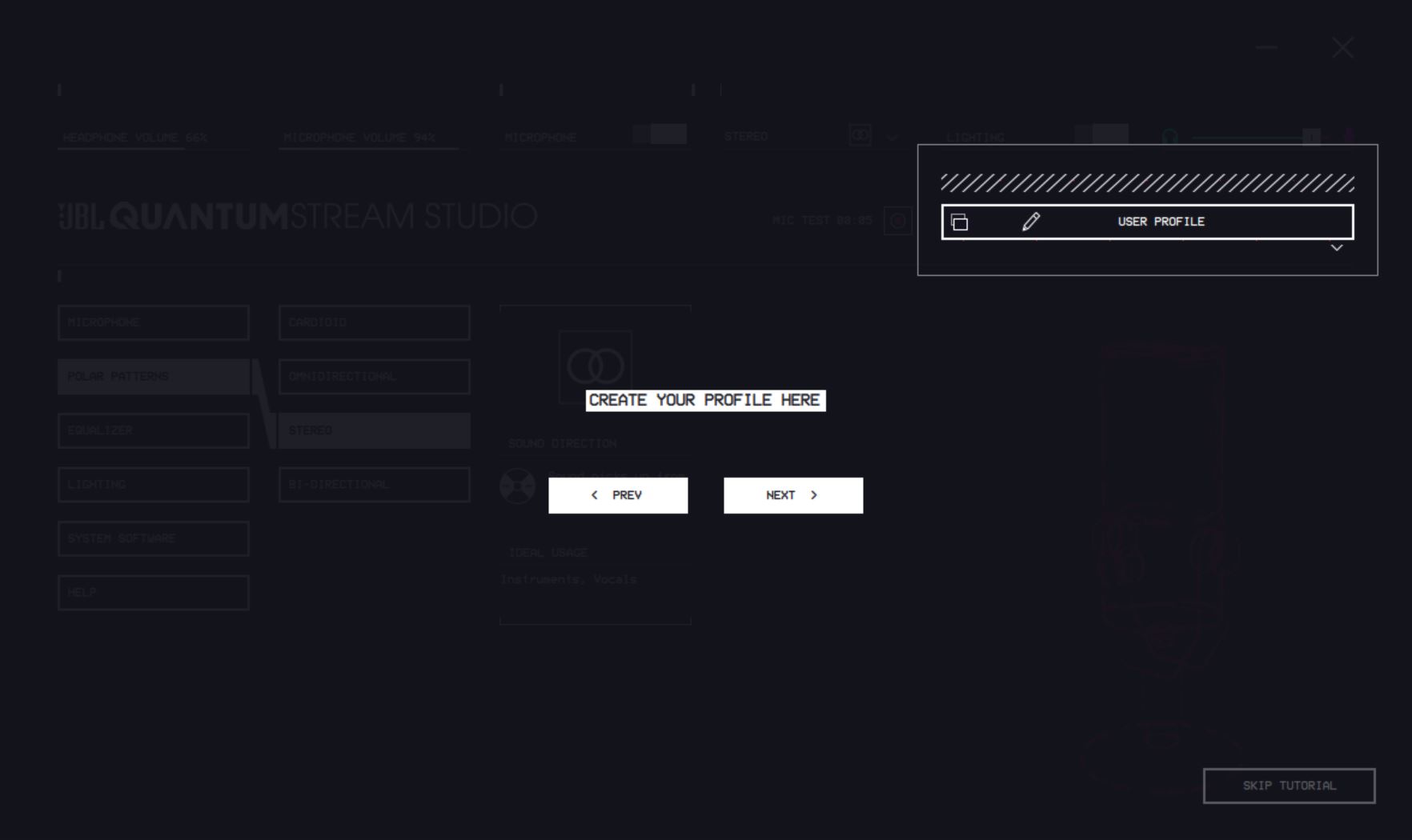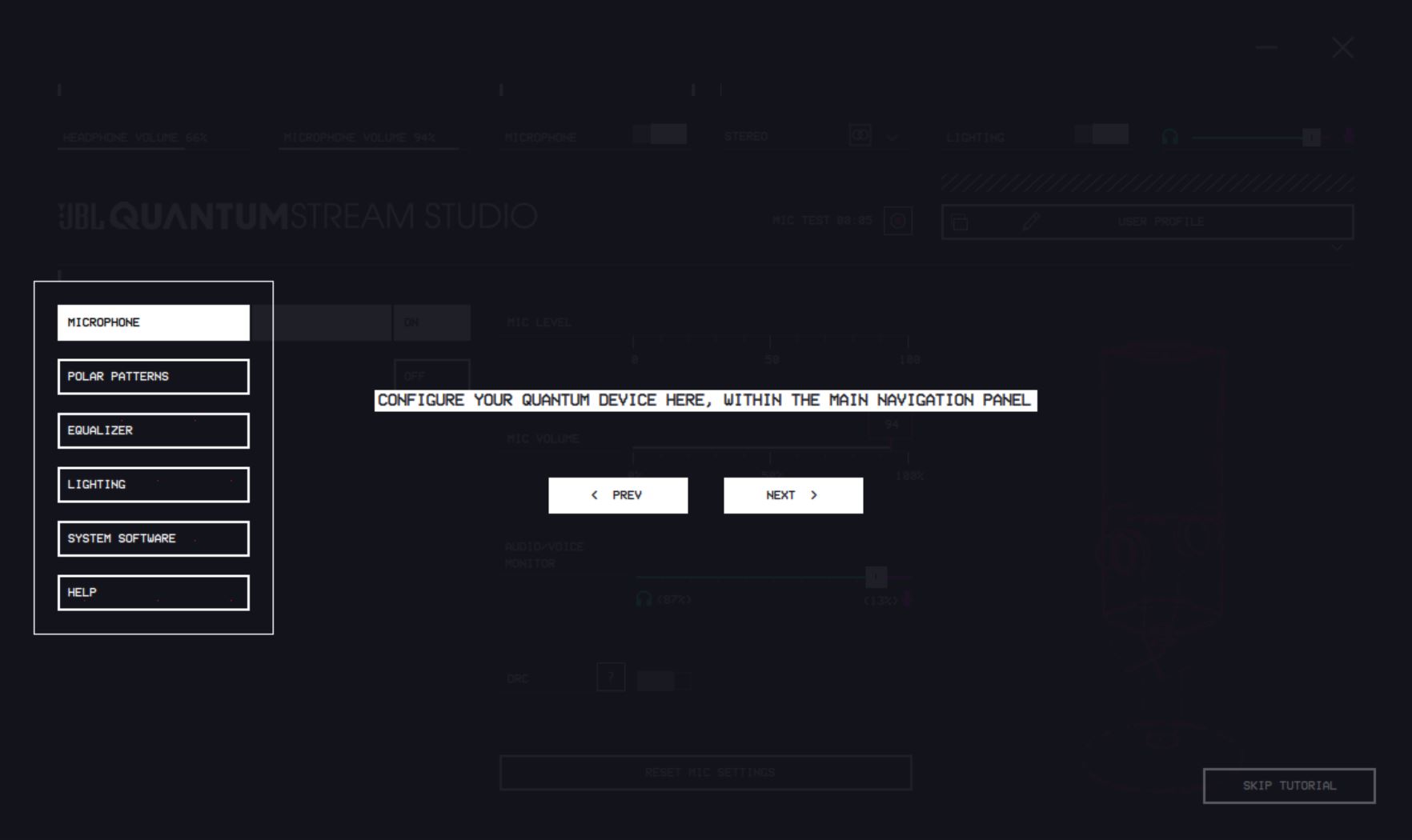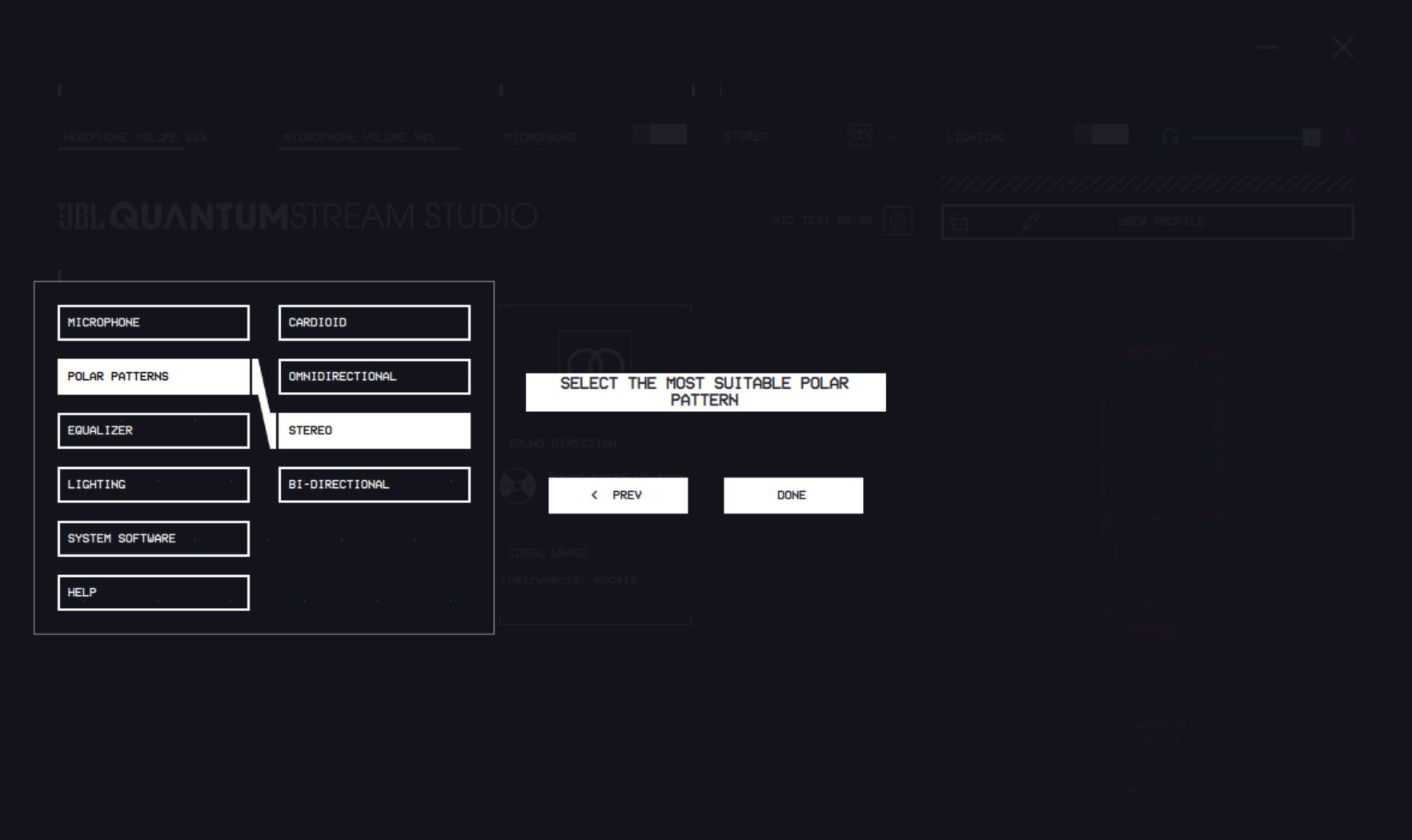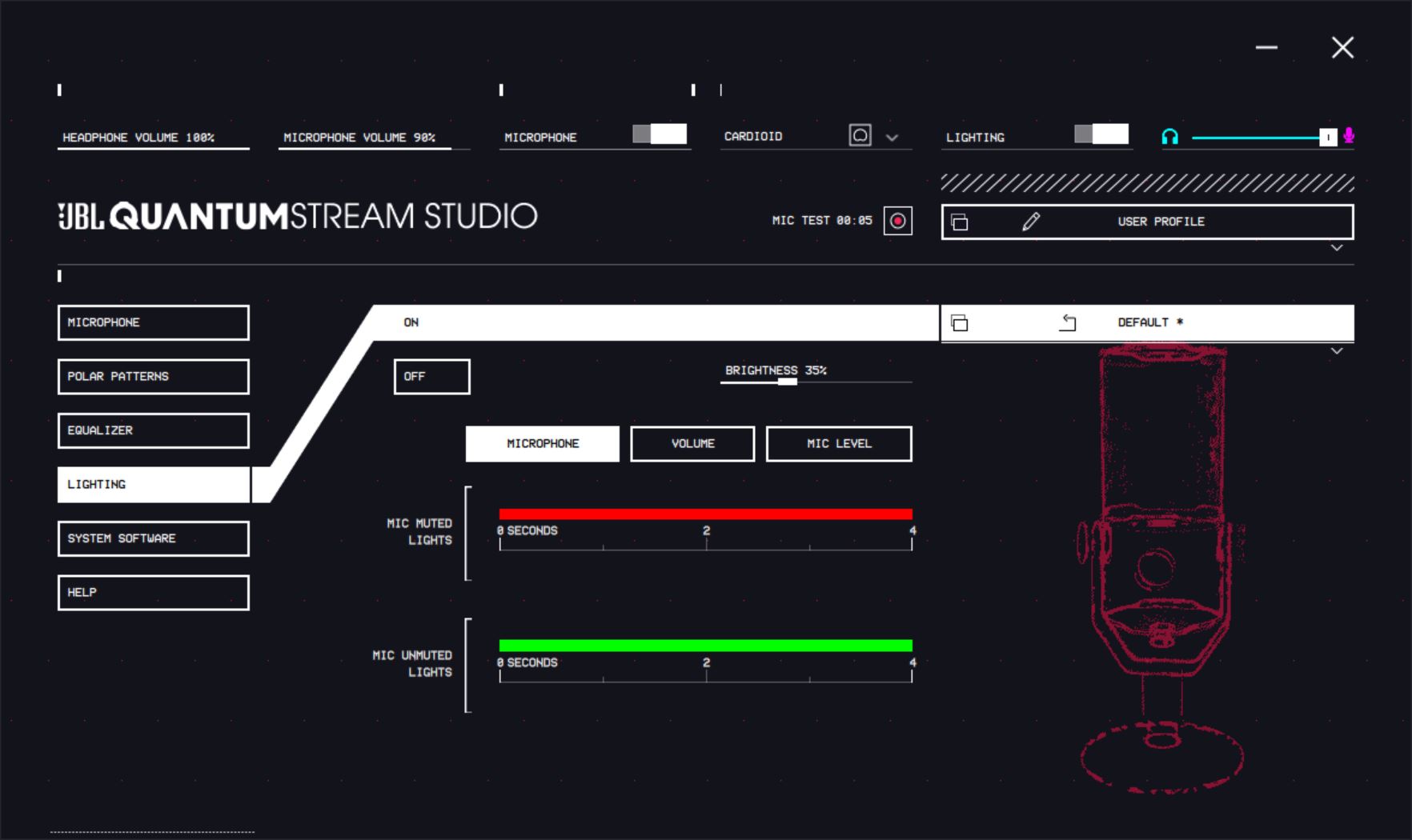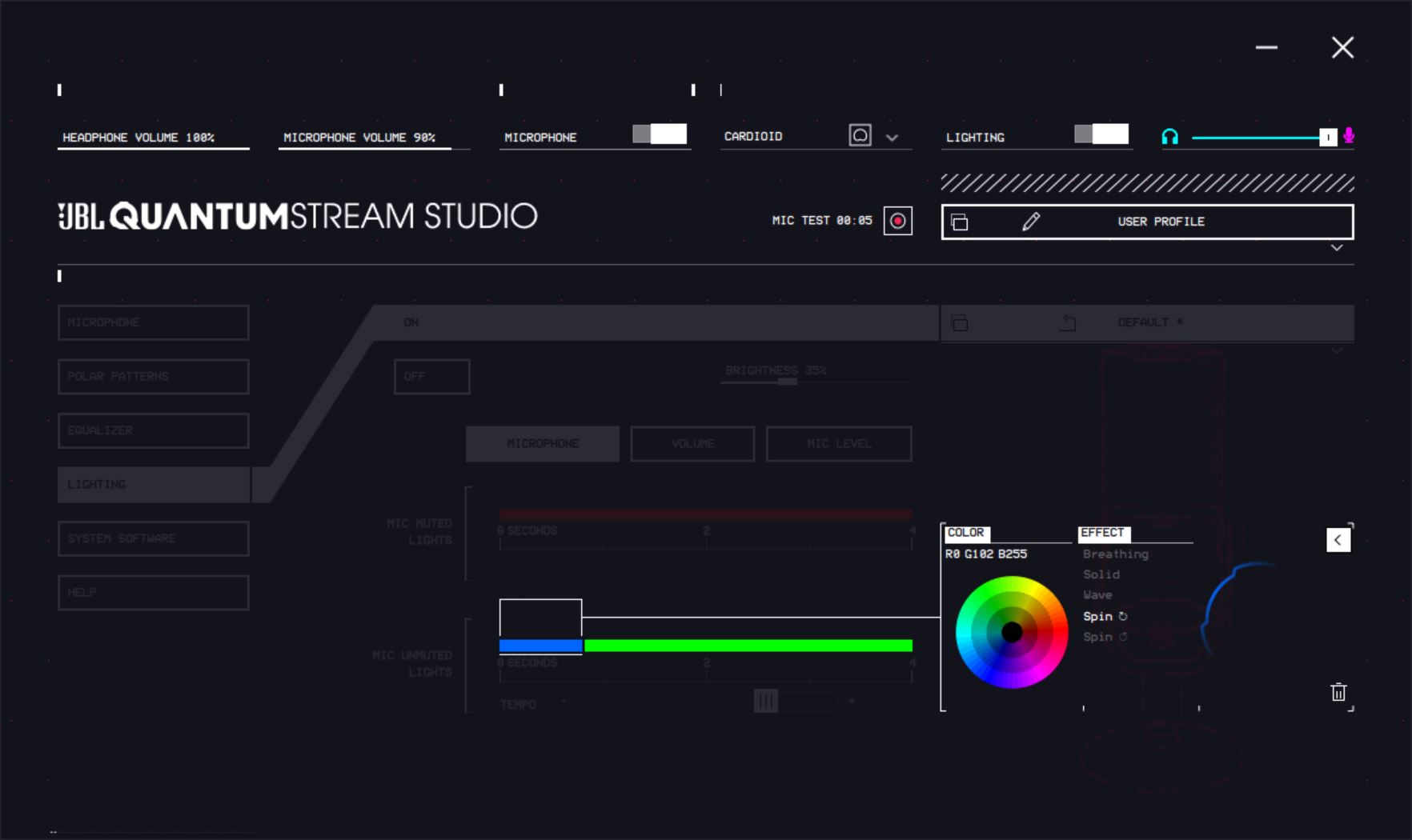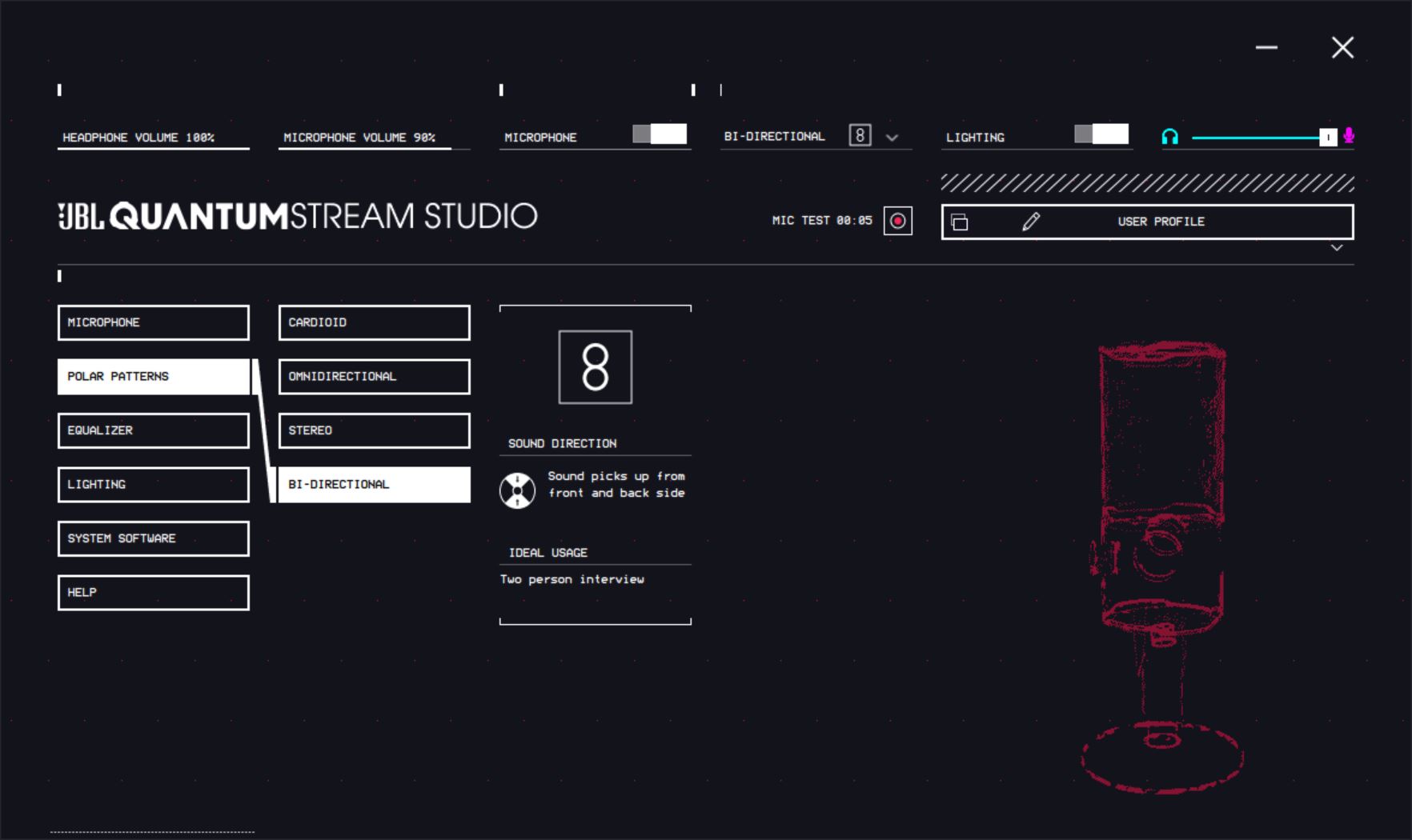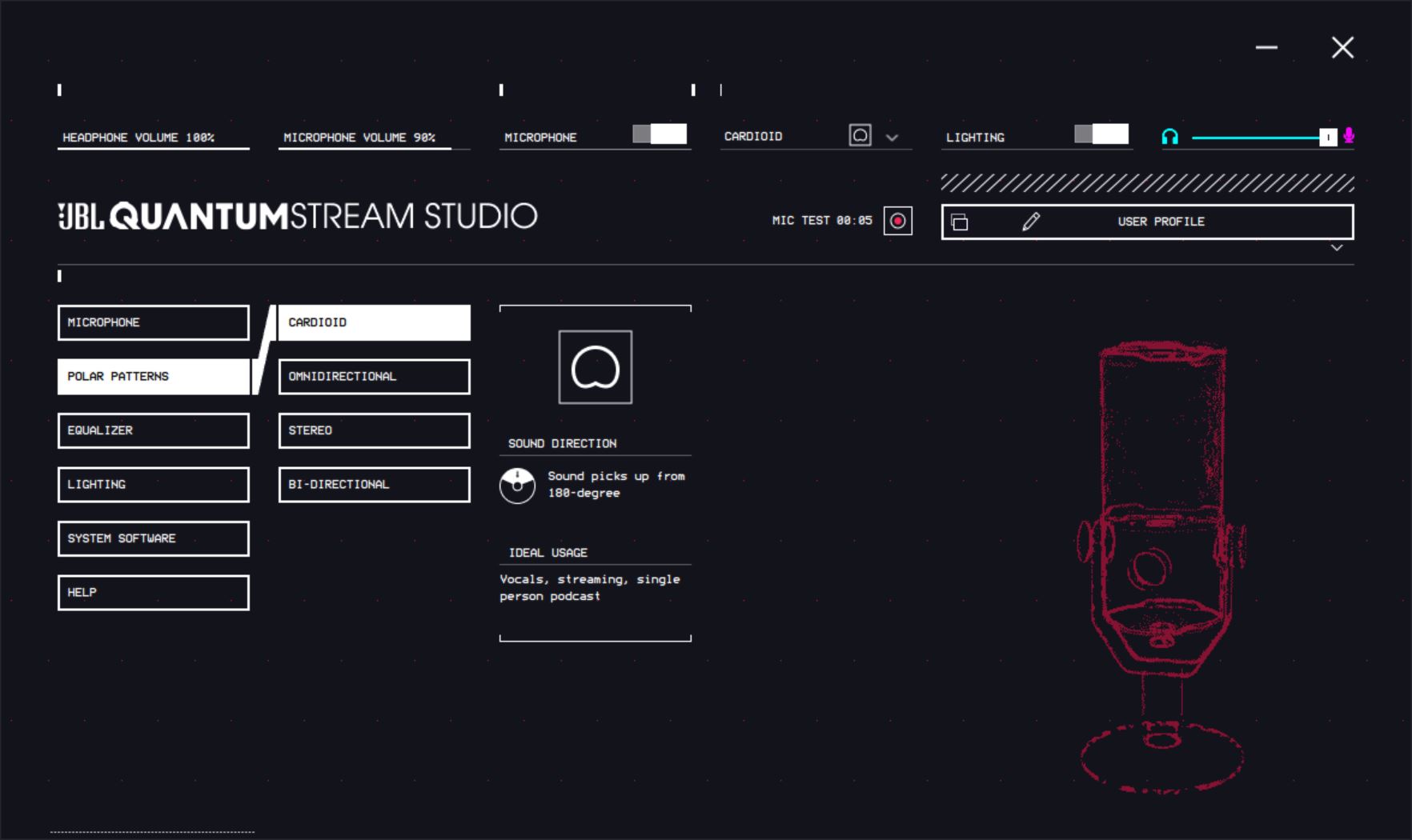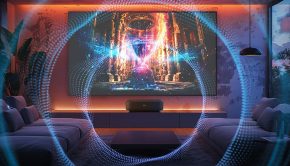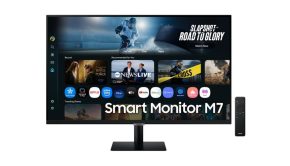JBL Quantum Stream Studio Microphone Review
JBL Quantum Stream Studio Microphone Review
Sound is survival Let your voices be heard
Sound like a pro with the JBL Quantum Stream Studio microphone. Whether you’re gaming, streaming or recording by yourself, with a co-host, or with a roomful of guests, you can quickly switch between four different pickup patterns so that everyone can be heard. No additional gear required to level up your game. You’ll always know how loud things are getting thanks to the RGB VU meter, and the dynamic range compressor makes sure everyone’s voice stays at the same level. Streaming a game? Fully control the balance between the game sounds and your own commentary. Use the included JBL QuantumENGINE PC software to adjust EQ, apply noise reduction, or customize the mic’s radiant RGB lighting.
Specifications
|
Frequency response |
50 Hz – 16 kHz |
|
Sensitivity |
-37±3 dB (1 kHz@1 Pa, 0 dB = 1 v/Pa) |
|
Maximum SPL |
110 dB |
|
Sample rates |
44.1kHz / 48 kHz / 96 kHz / 192 kHz |
|
Bit rate |
16 / 24 bits |
|
Capsules |
3 * 14 mm Electret Condenser Microphones |
|
Polar patterns |
Cardioid, omnidirectional, stereo, bi-directional |
|
Headphones Amplifier Impedance |
16 ohms / 32 ohms |
|
Headphones Power output (RMS) |
42 mWrms per channel (Load = 32 ohms) |
|
Headphones THD |
<0.5% (Load = 32 ohms) |
|
Headphones Frequency response |
20 Hz – 20 kHz |
|
Headphones Signal to noise |
92 dB with 48kHz sample rate, 93dB with 192kHz sample rate (A-weighted) |
|
Weight Mic with Stand |
582 g / 1.283lbs |
Source: JBL Quantum Stream Studio
Technical breakdown – Simplified
This microphone is aimed at the gamer, podcaster, YouTuber, interviewer and anyone else that intends to use the microphone to capture people talking.
Clear from the marketing speak above, but what also gives this away is the Frequency Response being only in average human speaking range of 50Hz to 16kHz. The full audible range of humans reaches up to 22kHz for most normal people, and it is in that upper range you appreciate the ‘air’ in a room, or the higher harmonics of musical instruments.
The 3x14mm Capsule or Diaphragm, is a disc shaped object which for all intents and purposes is a capacitor. It works similar to a drum and contains a very thin sound sensitive membrane that moves with the sound (vibration and air) that passes along it. The construction of this capacitor is such that the charge held in the capacitor increases and decreases with the movement of the membrane, ie when sound is present. This voltage differential is the up-peak and down-peak you would see in the waveform, and is how this device takes acoustic sound and converts it to a digital signal.
There are many great videos and writeups about this topic.
This video has a fairly substantive animation and picture of the capsule function.
JBL have three 14mm capsules in the specifications, which is a different approach to conventional studio microphones. A rule of thumb is that high quality studio microphones, especially for vocals and instruments, will contain 34mm capsules (as shown in the video above). JBL are using three 14mm capsules because these will (as started by ‘electret’) be self charged capsules which are cheaper and do not require additional circuitry to power them (typically called Phantom Power), all of which lowers manufacturing costs.
So does this mean JBL are cheapening out on the consumer? No, not necessarily. Whilst it is true that the 34mm capsules tend to be the sweet spot, the best sounding, capsules come in all sizes and there is a science to the construction and the materials used, all of which influence the quality of the input and the frequency response – and that is only one of many factors, not including voltage, circuitry and the microphone enclosure!
As a USB microphone, the supplied 5v provides a maximum of 2.5v peak to peak, which is not a lot of headroom for any microphone, especially for dealing with distortion, background noise and other undesirable sounds that customers will expect to be filtered out. JBL have chosen these capsules because of the frequency response characteristics for the target profile, and the USB sound delivery is optimal for this design.
The sensitivity profile, -37±3 dB (1 kHz@1 Pa, 0 dB = 1 v/Pa), is a complicated aspect. How low can an input sound be before it is background noise/or not picked up by the microphone? Analog.com explain these concepts further. This is usually not something that the average consumer needs to worry about, but here the testing shows that a 1 kHz tone was used (standard practice). Don’t worry about it. This microphone can pickup background noise coming from another room if you want it to.
The Maximum Sound Pressure Level (SPL) is how loud the sound going into the microphone needs to be before the capsule mechanically fails. Nobody can speak at 110db.
The Sample Rate and Bit Rate provided are very much standard now days. Simply put, the higher these values, the more digital data is captured to represent the audio, meaning that the quality is higher. It’s worth noting that most people probably won’t spot the difference, especially during a stream – of course once the question is asked everyone will swear they can. Where this makes a difference is for recording audio, being able to record, edit and apply effects is always better with the higher Bit rate and Sample rate.
The Polar Patterns is a product of the 3x14mm capsules. JBL can turn on one, or two or three together, to change the direction the microphone is sensitive to sound. Strictly speaking however, this microphone is a Side Address.
The other specifications amount to saying that your normal computer headset, headphones or earbuds with 3.5mm jack will work.
Unboxing & First Impressions
Visually the box is impressive. The gradient of colour and show of the light, with the simplistic and striking lit-up visual of the microphone.
All information is readily on the box, including the supported polar patterns and devices.
Immediately the weight of the JBL Quantum Stream Studio is felt and the contract of trust is signed. This thing will not slide around the desk, thanks to the thick rubber grip on the base. The weight and rubber will also prevent excessive vibration noise from being fully transferred to the microphone.
The unique and perhaps artisan designed grill is a welcome change from all of the standard microphone grills of generic microphones. It is modern, inviting and professional.
Design
The real metal enclosure from the stand to the case and mesh is impressive. No doubt, this is one of the significant design factors that reduces vibration noise and unwanted sounds, aiding in the dense full body sound profile and noise filtering/compression.
It is a welcome inclusion that a stand is included as well as the option to mount to any standard C-Clamp mount via the two screw terminals. The adjustment of the microphone angle is greater than 180 degrees in both directions and the movement is smooth without any weakness or flopping. It stays put after adjustment. Perfect.
The mute ‘button’ is actually a touch sensitive top pad with the mute microphone icon imprinted in the middle. Touch sensitive buttons are often problematic and although visually it is perfect, a latching or even momentary press tactile button located next to the rotary dial would provide more confidence. Interestingly, the polar pattern button is a tactile button and of course, the selection for the touch sensitive button is to avoid the microphone picking up a mechanical switch contact.
The polar selection button is easy to reach even with the microphone directly vertical, but feeling for it can still be awkward. A slightly larger diameter would have been more useful, although for most people this will be perfect as is.
The rotary dial which controls the microphone gain and mix of mic to monitor audio (hearing yourself as you speak) is smooth and the button responds perfectly, this appears to be a high quality rotary.
The included cable is a USB-C to USB A. This means that the microphone is operating on 5v USB Bus power, and the USB-C connectivity is for the most part, perhaps only going to offer better performance at higher 24 bit-depth and sample rates. Keeping in mind there is the return audio channel operating regardless.
14mm electret capsules are commonly manufactured with 2-wires, the use of three 14mm electret capsules indicate the circuitry design most likely has each capsule wired into the board directly and then the controller allows for series/parallel connections to achieve the desired polar pattern – it would be great to get a sneak peak inside to confirm, but opening this microphone, although possible – was not something that looked easy or simple to do.
The JBL Quantum Stream Studio is a well designed, well built and well thought out microphone.
Software
In contrast to the Quantum Stream Studio, the QuantumEngine application is visually unappealing and a detractor from the overall experience.
Installation is very straight forward.
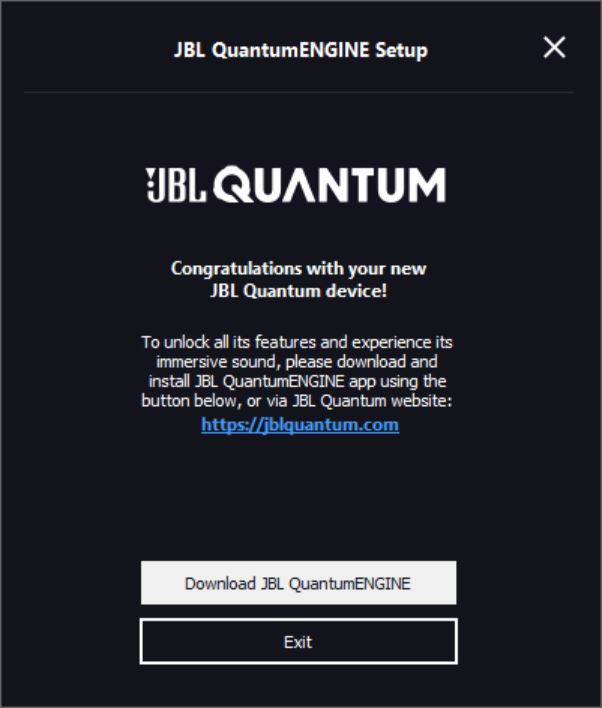
Upon connection, Windows probes the microphone and automatically prompts for the JBL QuantumENGINE to be installed.
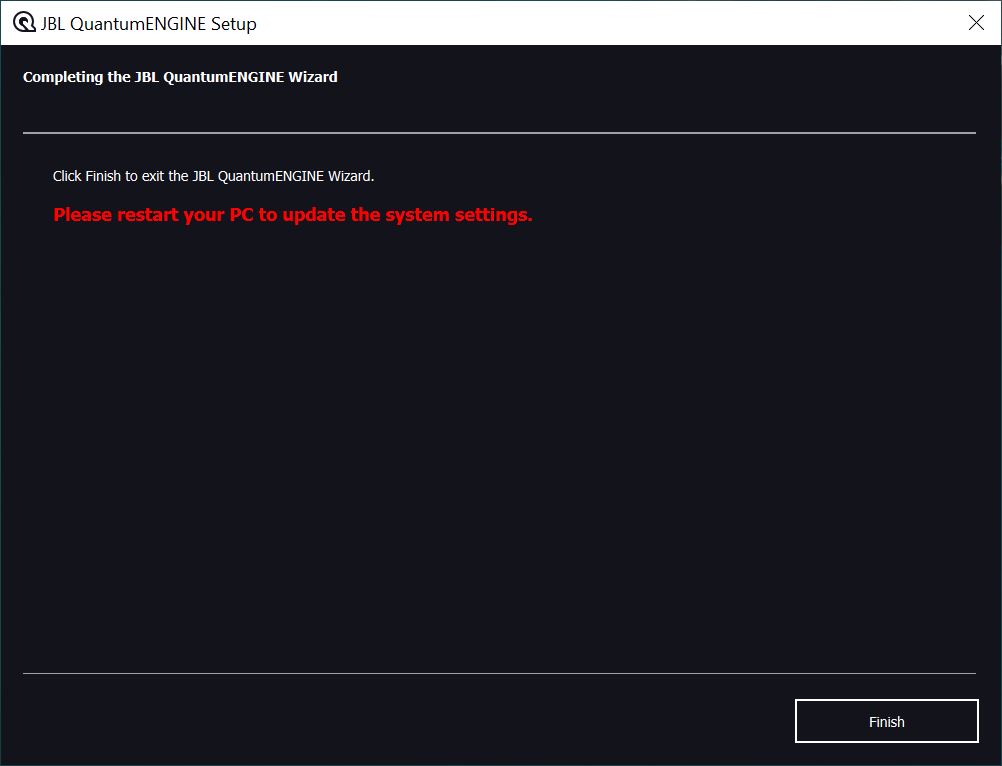
A bit sus’ and frustrating that a restart is required. Some crucial driver related elements obviously need to be started with Windows in order to work correctly.
After a restart, upon first launch, a new taskbar icon appears. From there the JBL application can be launched and the first time use welcome screen is presented.
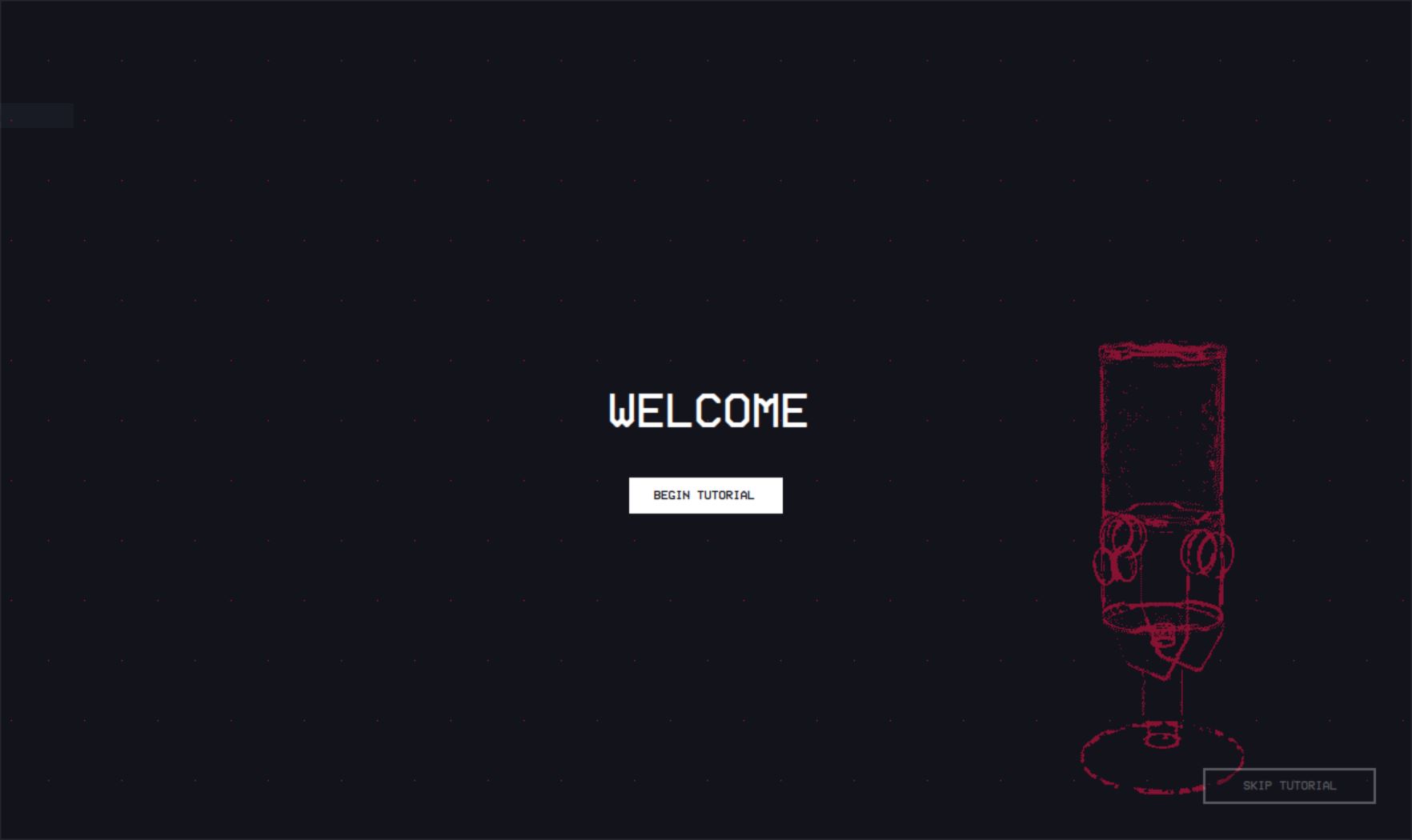
The tutorial can be skipped, and to be honest – its a nice feature but very few people will get overwhelmed with difficulty in the usage.
The tutorial is well put together and steps the user through each aspect of managing their microphone.
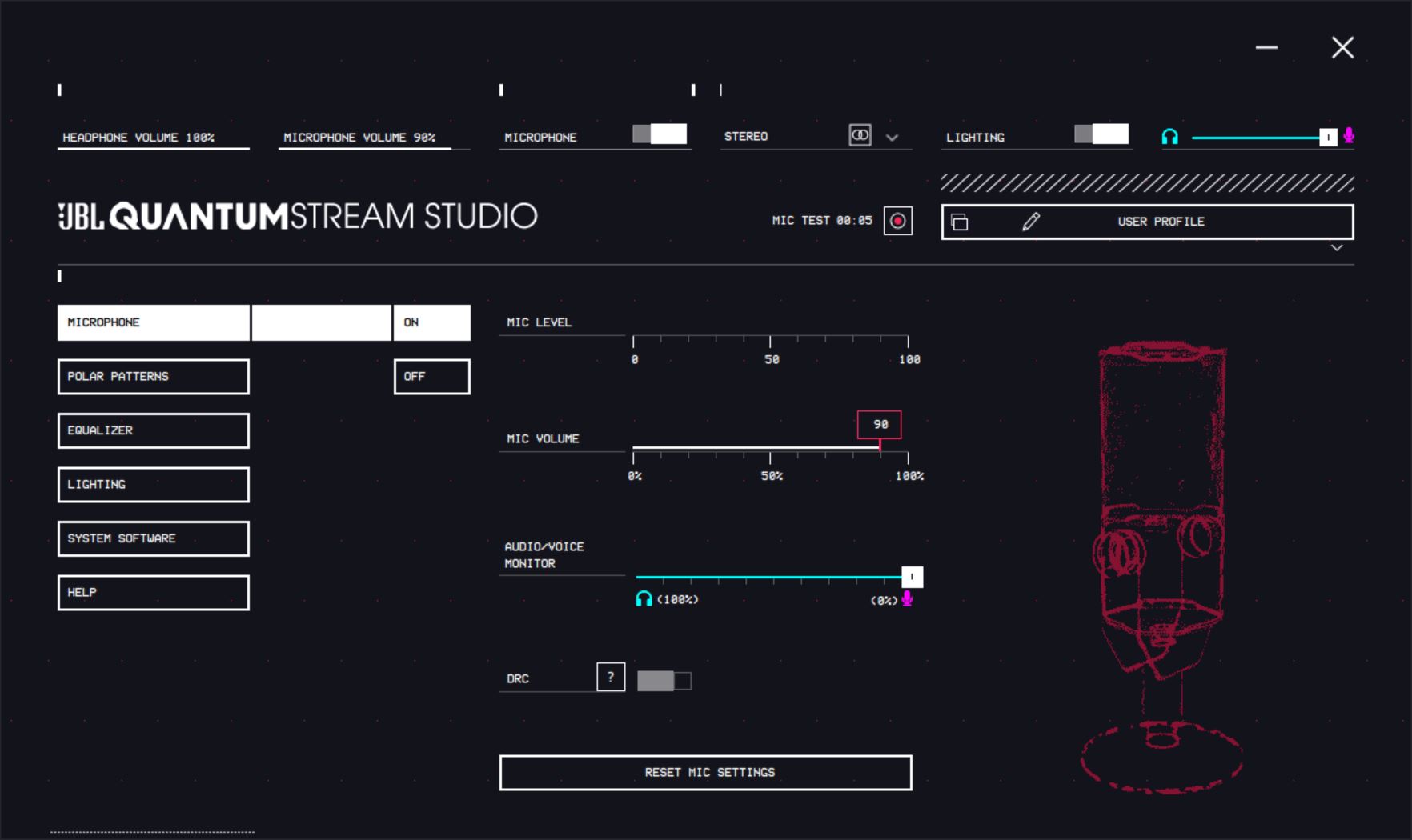
Tutorial finishes with the main screen, the Mic Level, Volume and “AUDIO/VOICE” (recording monitor) can be adjusted here.
Feature rich, the RGB lighting can be customised to any colour, including mixes at different durations, or simply disabled all together.
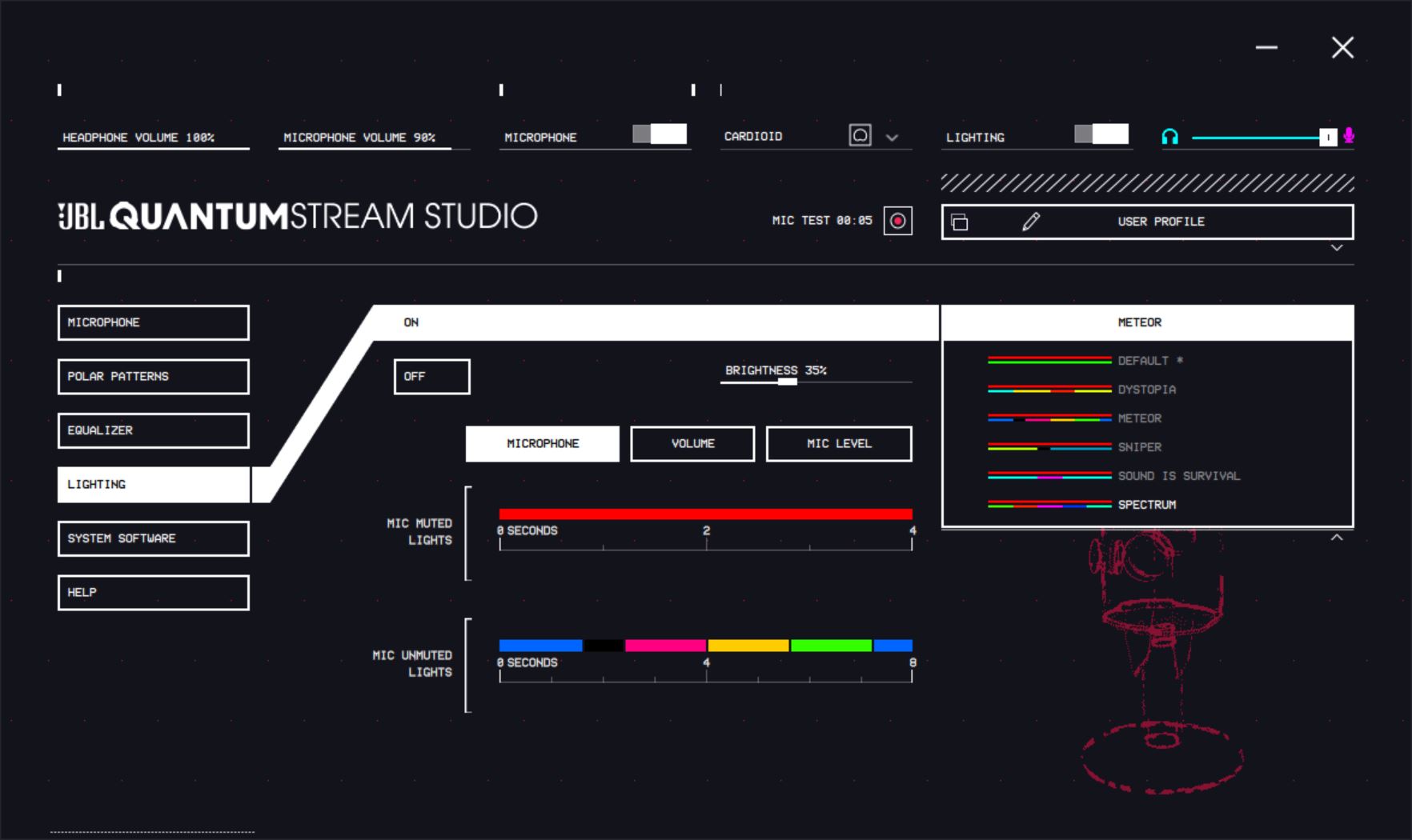
Built in lighting profiles, or you can make your own, because… changing lights all the time is the best use of your time.
Some sound features, including Equalizer allow customisations for noise suppression and audio playback. Most of which can be influenced without the application, eg direct via Windows.
Finally, the pickup patterns can be adjusted in Polar Patterns menu, and explanations are provided to select the most appropriate pattern.
Testing
Testing conducted on multiple systems including Mac OS, Windows 10 and Ubuntu Linux in a real-use application scenarios, connected with the supplied cable via USB A 3.0. No USB 2.0 port was available for testing.
Microphone
Zoom/Team meets – Video conferencing
Used exclusively with multiple people over two weeks, this microphone performed perfectly. All agreed that no background could be heard and at least one prompted comment of “yeah that sounds great”, was provided. Alas, this microphone does not overcome the compression/codec quality of the video conferencing services. The audience could not, or did not notice any difference in the polar patterns, although perhaps omnidirectional and stereo may have picked up further noise – if so, the platforms compress and filter it out.
Audacity – Audio analysis and background noise
In Linux, it was much easier to avoid some of the compression and signal processing that is present in Windows via the JBL Quantum software. Doing so opens up upper levels of sensitivity and at gains of greater than 70-80%, even background TV audio from another room can be picked up after normalising the audio.
At 16kHz, higher air and sound in the background noise loses some of the tonal quality and can range from an unpleasant to an uneasy sense that something is ‘missing’. On the other hand, the captured speaker is in the foreground and the presence is dominating, especially in the Cardioid and Stereo mode.
Unexpectedly there is increased sensitivity and sharpness in Stereo polar pattern for clicks, claps, and anything ‘Foley’. Binaural recording takes on new levels with spoken voice and clicks/claps through the Quantum Stream Studio; during playback the sound was so present and life like that it was a transportive experience and was as spectacular and equally frightening as a Hitchcock film.
When the JBL software compression is active, the sound is pristine and clear in terms of noise. it does however feel a little duller especially above ~4kHz, not that most people would notice. All of which can be overcome with correct placement, or more advanced audio processing in lieu of the JBL software.
There were otherwise no unexpected peaks, pops, or excursions even at full 24-bit, meaning the audio signal was constant and unwavering raw and compressed. Percussive tapping, scratching and the like were all as expected and at the appropriate amplitude.
The full envelope/range was recorded and no DC-offset was present. Everything lined up perfectly.
However speaker position did make a significant difference.
Thresholds and speaking positions
The proximity effect was a factor, but this microphone responds well – very well in the bottom end and it is not as strong as a Shure SM58 (famous for this effect). The reverse however is very true. The further away from the microphone, the more dramatic the top end drops, losing the full vocal clarity.
Unfortunately, at around 25-30cm, the appreciable top end almost walks off the cliff. This is to be expected, as it is one of those factors with the size of the capsule. Nevertheless, the amplitude of the capture is still favourable at 40cm distance, and as previously determined, even background noise can be picked up.
At 100% gain, some lost tonality and frequency response can be gained at the disadvantage of increased background noise. In reality this is okay for streaming if there is game noise, or video conferencing which compresses and suppresses background noise. The only consideration that needs to be given is for recording – at which point the microphone placement that most people will default to – in-between the main monitor and keyboard, will be at least 40cm or a good arm length away from the mouth, which means it is simply too far to capture the full voice.
The sweet spot for the gain is between 70-90% depending on the speakers position. The closer the speaker, the more the gain can be reduced and less software based noise suppression that would (need) apply.
What all microphone users know to be true applies here. This is nothing new. A mic boom is preferred.
Headphones/Playback
Playback of audio was crisp, clear and without delay. In particular, testing was done on the assumption that there may be delay in the playback, such as YouTube or gaming cut-scenes. None was detected.
Microphone monitoring also had no perceptible latency, considering that the audio signal was going through the computer USB Bus and back via audio return. This was verified whilst recording in Audacity.
In a practical sense, the microphone placement being in front of the keyboard meant that usage would require a cable be hanging over, or be pulled under the keyboard. It was not preferable to use this audio output in favour of any alternative (monitor, external sound card, inbuilt front audio etc)
Button & Rotary dial Response
The Polar Pattern selection button responds fast, and the corresponding LED instantly shows the change. The pattern can be changed whilst the microphone is in use. There is a detectable software ‘pop’ that can be seen in the recorded waveform, indicating that listeners may hear a slight small pop. Unfortunately, whilst the JBL Quantum software is open, the software also seems to interfere with the audio devices in Windows and this caused no end of annoyance with audacity making the device ‘unavailable’ for several seconds each time.
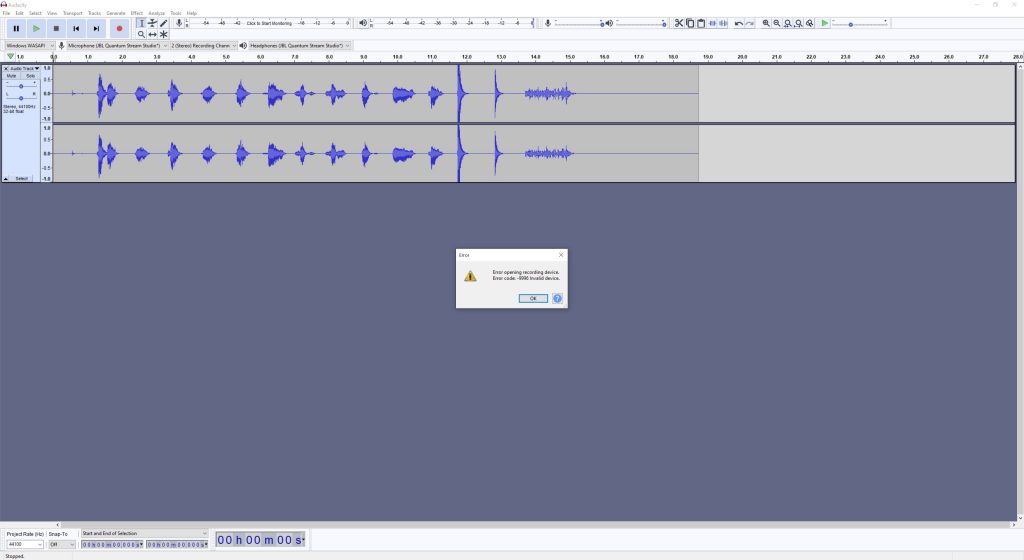
The previous recorded (non normalised) waveform was a great example of the stereo recording. Two claps were made toward the end on the 3rd and 2nd last grouping, whilst the last grouping is a scratch against the grill. Unfortunately changes to audio selection seems to lock out the device to other applications regardless of weather WaveMapper, direct sound, or WASAPI drivers were used.
The mute button was touchy pun intended. It takes half a second to respond and become available so a mute and instant un-mute is not possible without the mandatory 0.5-1 second pause. Moreover, a full separation from the capacitive touch is required, meaning the finger needs to be taken away possibly up to an inch distance before the button is capable to detecting a finger tap.
This delay of course, is the RC time constant for the circuit to discharge, so in fairness 500ms is not too bad.
The rotary dial is very fast to apply increase or decrease in the turn. The button itself is quite responsive, but perhaps difficult to centre in velocity. When the button needs to be operated, it seemed more comfortable and mostly required to also grip the microphone with the opposite hand in order to press and turn to change modes. There is likely to be some software update at a later stage or ability to adjust sensitivity – as this issue is not mechanical as such. Yet the experience was just a bit too ‘fiddly’. Microphone gain is easily adjusted in a lot of software and the monitor function is either going to be set, then forget, or not used at all.
Playback volume adjustment however, is perfectly smooth and operated via one hand, so really – there is very little to be concerned with.
Final Thoughts
The JBL Quantum Stream Studio is a very well designed and rock solid microphone, made by a company that knows and values great audio products.
For the target market, this microphone is a great all-rounder that offers genuine studio quality via a simple USB connection, eliminating the need for XLR to 3.5mm jacks, or special power supplies to connect a studio microphone to the computer without a mixer, thus making the application simple, easy to use and accessible to anyone.
The choice of the 14mm electret capsule and supportive circuit design allows for the connectivity for PC, Mac and PlayStation and likely any other device that supports USB sound devices, which makes this studio microphone a versatile multi-use product.
It was an effortless joy to review the JBL Quantum Stream Studio and is a no brainier to recommend this product to anyone who is looking for an easy to use, high quality studio microphone for Podcasting, Video conferencing, Streaming and interviewing.
Summary: JBL QuantumENGINE software is garish to look at, but the JBL Quantum Stream Studio is almost complete perfection. A worthy companion to for any Podcaster, Streamer or Interviewer (or really anyone else!).


